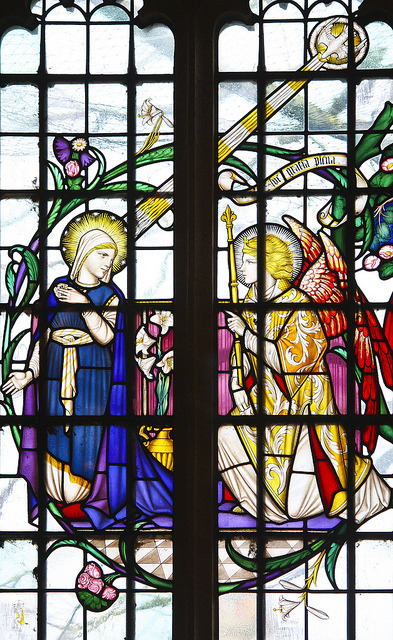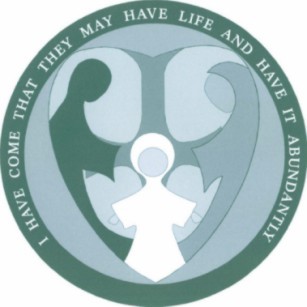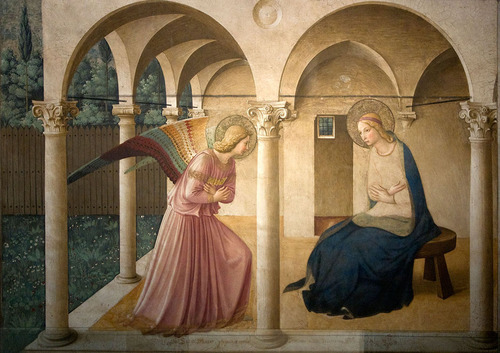Meditation for the Annunciation on the Angelic Salutation
by fr. Lawrence Lew OP and recorded for Eternal Word Television Network which was first broadcast today, 25 March 2014.
 In the United Kingdom the financial year begins in April, and many of us will know that the 1st of April is also known as ‘April Fools’ Day’. It’s thought that the pranks and jokes played on this day were meant to make fun of those ‘fools’, so called, who refused to observe the new Gregorian calendar introduced in France in 1582. That calendar had moved the new year to the 1st of January which is, of course, the day we generally accept as the beginning of the new calendar year. But what the ‘April fools’ of the financial sector recall is a much older and indeed, wiser, tradition. The new financial year begins in April because until 1752 in the United Kingdom, the new year began on Lady Day, that is, the 25th of March, the feast of the Annunciation.
In the United Kingdom the financial year begins in April, and many of us will know that the 1st of April is also known as ‘April Fools’ Day’. It’s thought that the pranks and jokes played on this day were meant to make fun of those ‘fools’, so called, who refused to observe the new Gregorian calendar introduced in France in 1582. That calendar had moved the new year to the 1st of January which is, of course, the day we generally accept as the beginning of the new calendar year. But what the ‘April fools’ of the financial sector recall is a much older and indeed, wiser, tradition. The new financial year begins in April because until 1752 in the United Kingdom, the new year began on Lady Day, that is, the 25th of March, the feast of the Annunciation.
It is fitting that Lady Day, the old English name for the day of the Annunciation, should have marked the passing of each year because the event it commemorates is truly epoch-making. Indeed, the Annunciation initiates a new creation; the cosmos redeemed by grace; and heaven and earth embrace. As a 15th-century English carol put it: “For in this rose containèd was/ Heaven and earth in little space, Res miranda”. And the “rose of such virtue” of which that carol sings is Our Lady; her womb, the “little space”, in which heaven and earth embrace because of the Incarnation of Jesus Christ. Truly, this is a res miranda, a marvellous thing wrought by God’s grace.
So, for two millennia, Man has marvelled at God’s work in the Incarnation. We have delighted in the wonder of the Annunciation – that moment when God became Man at Our Lady’s Fiat – through carols, music, sculpture and art; through countless sermons, poems, meditations and prayers. And today I add another: ros ad Maria, a tiny dew drop added to the oceans; a little offering to the Blessed Virgin Mary.
Let me explain that phrase, ros ad Maria. An ancient Dominican tradition holds that when Our Lady gave the Rosary to St Dominic, she said something to the effect that “heresy should not disappear until prayer should rise from the earth like drops of dew”. Hence, the word ‘rosary’ comes, not from roses, as it is often thought, but probably from the Latin ros, meaning ‘dew’. Each bead of the rosary is thus like a drop of dew that rises from the earth – a prayer; a praise to the Virgin; a sweet word that refreshes the earth and infuses our dry hearts with the grace of the Ave. Thus, I offer today ros ad Maria – a reflection to add to the rosaries of words, songs, and art already said about Lady Day; a dew drop to catch the light of Truth that Christ comes silently as dew-fall into his mother’s immaculate womb. As another 15th-century English carol says: “He came all so still/ There his mother was,/ As dew in April/ That falleth on the grass”. I offer this ephemeral drop of dew to praise Mary.
And this, too, is fitting on Lady Day: that we should cry out to Our Mother and Our Lady in praise when we think of the Annunciation of the Lord. For, as the 6th-century Byzantine hymn to the Blessed Virgin, the Akathist hymn, sings: “The Maker of heaven and earth covered you with His shadow, O Pure One, and came to dwell in your womb, and taught us all to cry out to you: Rejoice…!”
So, we shall begin here, too, with the angelic salutation which the evangelist St Luke gives in Greek as Chaïré, kécharitôménê! Now, this opening word, chaïre can simply be a greeting like ‘hello’. This is the sense it takes when it is translated into Latin as Ave, and it is rendered into English as ‘Hail’. But you’ll have noticed that the translation I’ve been relying on for the Akathist hymn, and which we find in some Lectionaries, notably the Jerusalem Bible translation which is used in most British parishes, says: “Rejoice”! This is because the word chaïre does have that stronger secondary meaning of an invitation to joy. Something similar, perhaps, can be seen in the Filipino greeting ‘Mabuhay’ which is simply used as a ‘hello’ or a ‘welcome’ greeting. But it also carries that deeper resonance of an invitation to rejoice in life – buhay in Filipino – itself.
Certainly, the tradition of the Greek Fathers of the Church and the Greek Byzantine liturgy has been to see in the angelic salutation an invitation to joy. So, for example, St Sophronios, patriarch of Jerusalem from 638, said that “when [St Gabriel] addresses [the Blessed Virgin Mary], he begins with joy, he who is the announcer of joy”.

Thus the Dominican Rosary rightly begins the Joyful Mysteries with a meditation on the Annunciation, this great feast of joy at the Incarnation. And we rejoice in the Incarnation, of course, because it is through the Incarnation of the Second Person of the Holy Trinity that God wills to save Mankind from sin, death and evil. Thus the Akathist hymn says: “Desiring to save the world, the Creator of All came down to it of His own will”. Even more beautifully, the Akathist hymn sings that “When the power of the Most High overshadowed the one who had never known the nuptial bed, her fruitful womb conceived, and she became for all a delicious field: for those who wished to reap salvation…” So, we rejoice with Our Lady at the angel’s greeting because we rejoice in the promise of salvation through the God-Man, Jesus Christ.
Not surprisingly, then, the Greek greeting chaïre is often found in the Greek translation of the Old Testament, the Septuagint, when salvation is promised to God’s beloved People. For example, Zephaniah says: “Rejoice and exult with all your heart, O daughter of Jerusalem! [For] the Lord has taken away the judgments against you, he has cast out your enemies. The King of Israel, the Lord, is in your midst; you shall fear evil no more” (3:14b-15). From this prophetic text of deliverance by the Messiah, we can hear a resonance of St Gabriel’s words to Our Lady, she who is the “daughter of Jerusalem”. Thus, as the prophet says “the Lord is in your midst”, so the angel says to Mary, “the Lord is with you” (Lk 1:28). And as the prophet says “you will fear evil no more”, so the angel says to Our Lady, “Do not be afraid, Mary…” (Lk 1:30). For at the Annunciation, the promise of salvation and Israel’s deliverance is fulfilled. And this is not just a deliverance from Israel’s political enemies, but more significantly and definitively, liberation from the Enemy of all Mankind, namely death (cf 1 Cor 15:25). So, the angel’s greeting is full of Messianic promise and expectation, and it is a signal for Man to rejoice in the advent of his salvation.
But on another level, it is natural and human to rejoice upon receiving news of a conception. For every conception of a child is a cause for joy because it involves a sacred act. It is that unique act by which God and Man work together to bring about a new human person, body and soul. God infuses the immortal soul into a body given by the human parents. Spirit and matter come together as God and Man co-operate in the divine act of creating a new human being. So, even if a mother might worry about how she is to provide for the material needs of her new child, or even if the circumstances surrounding the child’s conception are not ideal, the gift of new life is always a cause for joy and hope. So, the angelic greeting, indeed the imperative, “Rejoice”, is a reminder to every Christian of this: that, in faith, any news of a conception can be received with joy.
The Akathist hymn gives us some hint of this dynamic. For Our Lady was clearly surprised by the circumstances of her conception. Indeed, the Fathers stressed that all creation marvelled and was surprised at this res miranda, this spectacle of grace. But Mary is, it seems, in some way comforted by the angel’s call to rejoice; it is a call to faith in divine Providence. The Akathist hymn puts it like this: “Knowing that she was a virgin, the Blessed One courageously answered the angel: “Your surprising words seem hard for my mind to accept: how can you speak of a birth that is to come from a conception without seed? And why do you cry, Alleluia?” Here, the cry ‘Alleluia’, which literally means “Praise God”, is also a cry of joy. It is thus a reference to the angelic salutation chaïre! So, Our Lady’s consternation at the angel’s message is in some way re-assured by St Gabriel’s cry of joy. It prompts her, then, to seek, in faith, to understand the angel’s message and to say ‘Yes’ to God’s will. In this way, Our Lady shows herself to be the first theologian since theology is, as St Anselm said, “faith seeking understanding”.

In an analogous way, I think every mother is faced with moments when she needs faith and some understanding to carry a child to birth. I have seen young mothers, first-time mothers, uncertain and a little trepidatious. But at the same time, they have the courage and faith to say ‘Yes’ to a pregnancy because they are supported by the love, joy, and understanding of those around them. Where this is lacking in society, we Christians must be the angels who say, “Rejoice”, and then support those mothers in need. There is a Pro-Life charity I know of in Glasgow (Scotland) which has this at the core of their mission: to provide love and support to women in so-called ‘crisis pregnancies’. This approach of joy and hope and practical help is desperately needed in a world which is full of pessimism and cynicism. There is something almost Manichean about the approach of some people to conceptions and pregnancy.
What I mean is that there was a 4th-century heresy called Manichaeism that regarded the conception of human beings as something to be avoided; “maternity was a calamity”, and procreation was abhorred. Is there not some resonance of this in our time? And is not the Annunciation, with the angel’s call to ‘rejoice’ at the Lord’s conception, at any pregnancy, indeed, an antidote to this heresy and modern-day sadness?
According to Pope St Leo the Great, the Manichees even found the very idea of Our Lord’s conception and growth in Our Lady’s womb to be distasteful. He says: “It seems scandalous to them to believe that God, the Son of God, enclosed himself in a woman’s innermost parts and that his Majesty was submitted to the indignity of involvement with the nature of flesh and birth in the true body of human nature”. And yet, it is precisely this marvel – the divine Redeemer in the womb of a woman – that Lady Day celebrates and revels in. St Ephrem the Syrian, great 4th-century poet and mystic of that most venerable and ancient Church – may he pray for them – thus said: “It is a source of great amazement, my beloved, that someone should enquire into the wonder of how God came down and made his dwelling a womb, and how that Being put on the body of a man, spending nine months in a womb, not shrinking from such a home…” In fact, every Sunday and feast day when the Church sings the Te Deum, which is contemporaneous with St Ephrem, we echo these words, and thus, the Church refutes the Manicheans by saying: “When you took our nature to save mankind, you did not shrink from birth in the Virgin’s womb”. This embrace of heaven and earth, of spirit and matter, of God and Man when the eternal and divine Word takes flesh in a Galilean woman’s womb, is what we celebrate on the Annunciation. The mystery of the Incarnation is thus a celebration of God’s embrace of humanity and all creation; of God’s nuptial union with Man; of his ‘Yes’ to Mankind even as Our Lady gives our ‘Yes’ to God. Thus, the Akathist hymn hails Our Lady as “Bride and Maiden ever-pure”.

Given the importance of the Annunciation for combatting the dualist heresy of Manichaeism, it is not surprising then that it should have a central place in the devotional life of the Dominicans. For we were founded to combat a 13th-century version of Manichaeism that flared up in the south of France, namely Albigensianism. So, for example, we find in the Dominican priory of San Marco in Florence, a fresco by Blessed Angelico of the Annunciation. It is placed on the landing at the top of a flight of stairs leading to the dormitory. Below the painting is inscribed these words: “When entering and standing in front of the pure Virgin, do not forget to say an ‘Ave’”. That is to say that upon seeing the Virgin, whose hands are resting over her expectant womb, we’re to say the angelic salutation: “Rejoice!”.
And for what might the Dominican have said ‘Rejoice’? The Akathist hymn with its many invocations of Our Lady can help us. Perhaps, when about to head to the library for study he could say “Rejoice, who draws us from the depths of ignorance. Rejoice, you who enlightens many with knowledge.” Or, when about to head out for a preaching mission: “Rejoice, never-silent Voice of the Apostles. Rejoice, never-conquered Courage of the Martyrs!” Or, when headed into his cell at night: “Rejoice, you who abolished the corrupter of hearts. Rejoice, you who gave birth to the Sower of chastity”. And the Ave is taken up again in the Rosary, of course, that most distinctive of Dominican prayers.
But what about the second word in St Gabriel’s greeting? If the Jerusalem Bible has done well to translate chaïre as ‘Rejoice’, the translation of kécharitôménê as ‘highly favoured one’ is less felicitous. Here, I think the Latin gratia plena captures the Greek text better but even “full of grace” is not quite accurate. For St Luke also refers to St Stephen as being “full of grace” but he doesn’t use the word kécharitôménê. This Greek word in this form is extremely rare, and in fact it is only applied to Our Lady. The form of the word refers to some effect being caused by something. In this case, the causing ‘thing’ is charis, grace, which is thus effecting some change. The sense, as the Greek Father St John Chrysostom affirms, is that of being transformed by grace. So, what the angel calls Our Lady is effectively, She-who-has-already-been-transformed-by-grace. So, St Sophronios of Jerusalem says that the angel is saying to Our Lady that “no one has been fully sanctified as you… no one has been purified in advance as you”. The doctrine of the Immaculate Conception is thus founded on this word in St Luke’s Gospel, and there is truly no one else in God’s creation like the Immaculate Virgin.
Hence, a medieval version of the Akathist hymn says: “Gabriel was rapt in amazement as he beheld your virginity and the splendour of your purity, O Mother of God, and he cried out to you: ‘By what name shall I call you? I am bewildered; I am lost! I shall greet you as I was commanded to do: Chaïré, kécharitôménê!’”
And we? What else can we do when we ponder this great feast of the Lord’s Incarnation in Mary’s womb; contemplate the pivotal event of our salvation; behold the new creation of the cosmos through grace? We would be lost for words at this res miranda too, if we did not also take up the angelic salutation. And then, as poor struggling sinners, we add the words which first appeared in print in 1495, in a book by the Dominican Savonarola: “Holy Mary, Mother of God, pray for us sinners, now, and at the hour of our death”. Amen.
qcq liked this
mrrefragable reblogged this from lawrenceop
 notrecroisade liked this
notrecroisade liked this lawrenceop posted this